This article has been long overdue ,it took me a lot of time to research .Since I’d chosen a religious topic (which is not easy to write) I had to navigate carefully keeping in mind that many sentiments are associated with Azadari or (Mourning for Imam Hussain a.s.)
Azadari is a Persian word,it consists of Arabic word ‘aza’with Persian word ‘dari’.It means mourning ,mournful or to have mourning.
I’m no expert on Azadari ,I had to talk ,consult and take help from people who have more expertise and knowledge.
It was interesting to discover a new aspect of Azadari,i.e the motifs and their meanings on Alams.
There had to be a reason behind them ,the logic,hadith or stories from the life of Prophet Muhammad and his blessed family ,I often wondered.These questions puzzled my mind ,and I ventured into a beautiful journey unearthing them one by one.
During the course of my study on this subject I came to the conclusion that the signs and symbols associated with Azadari represent something beyond themselves , they could be abstract or natural or cultural signs .As one religious scholar puts it , “sometimes the mind of a man can go beyond books, into his imagination of something he associates deeply.”
Alam and their motifs:
(1) Rauza :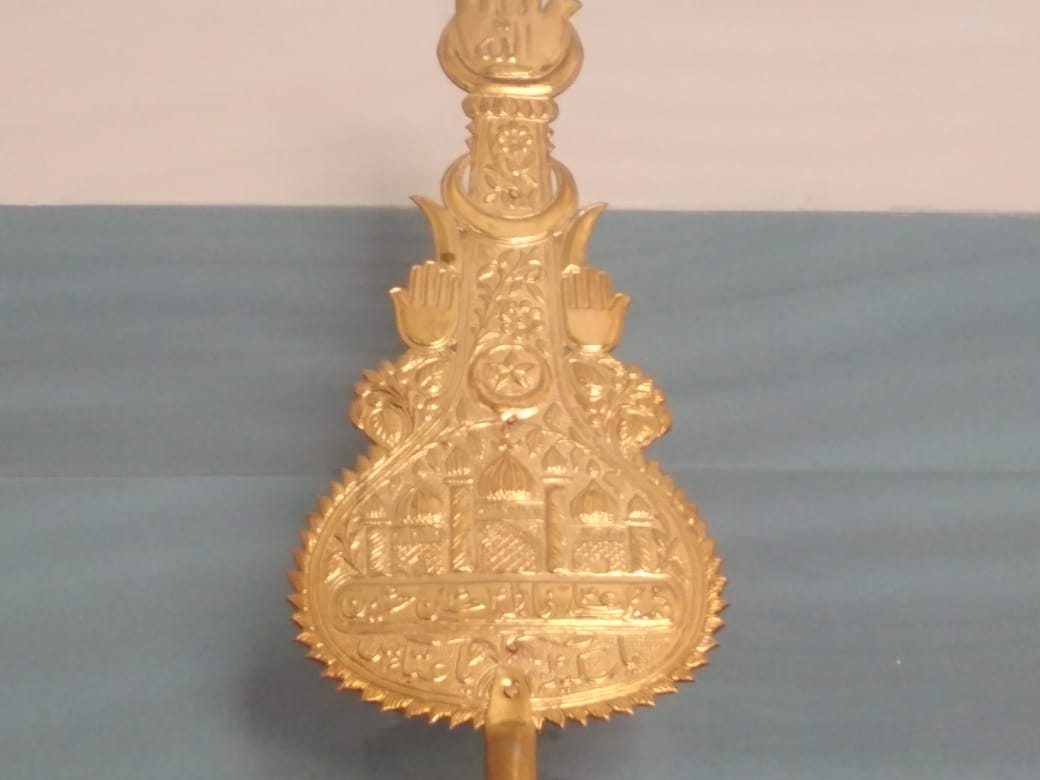
The rauza or tomb of Imam Hussain which is situated in Karbala Iraq,forms a place in motifs on Alams especially in Northern India. This motif is a tribute to the sacrifice of Imam Hussain who was brutally killed in the Battle of Karbala in 680 A .D.after he refused allegiance to Yazid (self proclaimed Caliph of the Muslims).
(2) Peacock: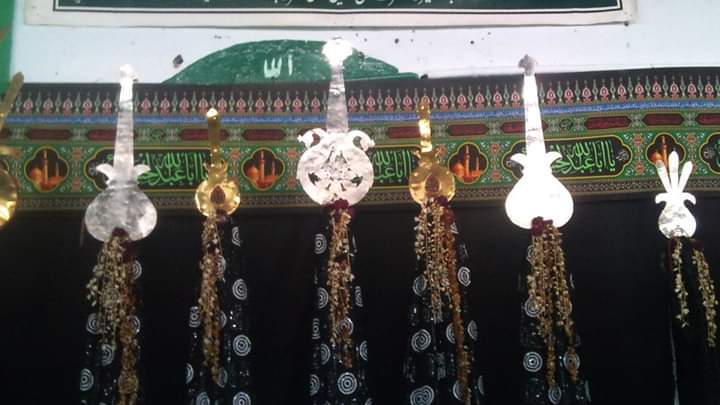
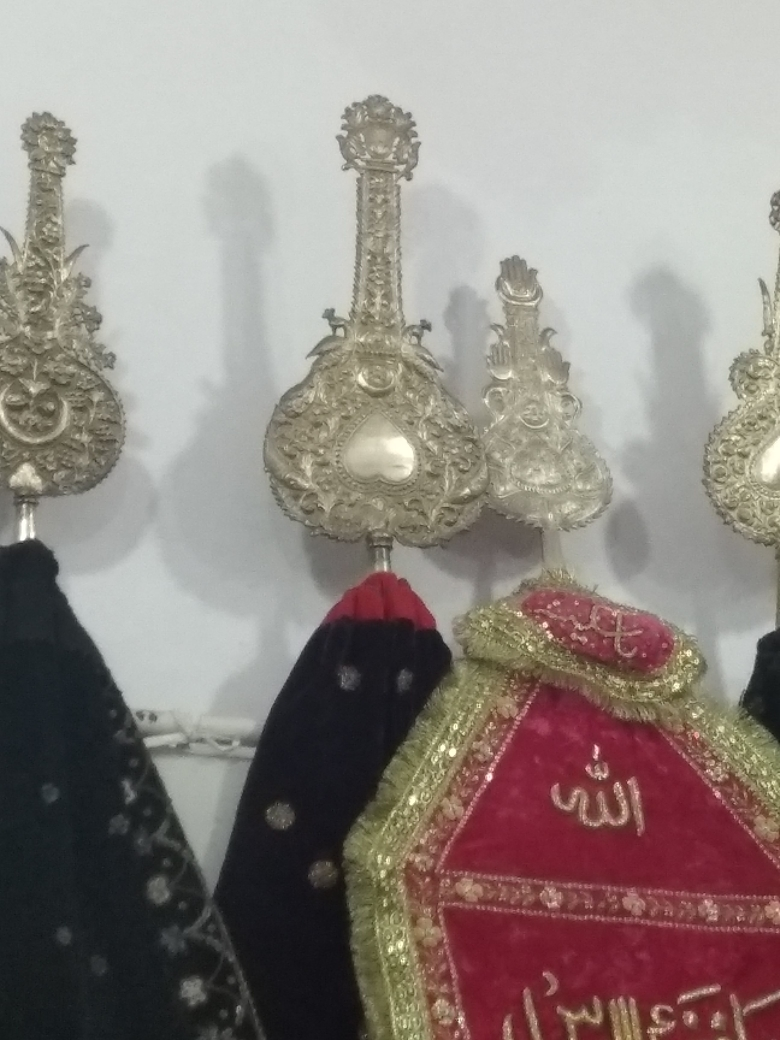
Peacock on Alam enhances the beauty of the Alam . It’s a beautiful creation of God and one hadith of the Holy Prophet,says “Allahu Jamil ya Yuhibbul Jamal “,which means,(God is beautiful and He loves beauty).Nature bears witness to the majesty and beauty of God’s creation.
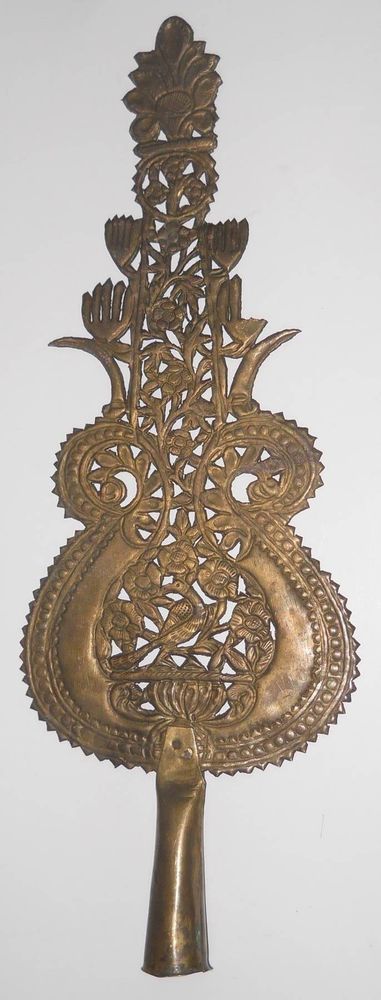
Peacock is considered a national bird of India ,it can very well present a beautiful angle of the Ganga -Jamuna tehzeeb of our culture.
A beautiful quote by Edward .T. Hall that,”culture is not made up but something which evolves which is human “,sums up my view on this subject.
Peacock motif has been a favourite among the great rulers and kings.The very famous Peacock Throne (takhte taoos)built by Shah Jahan was very famously robbed by Nadir Shah Afshar in the Battle of Karnal 1739.Since then the Peacock motif has been associated with Persian imperial might .
(3) Doves: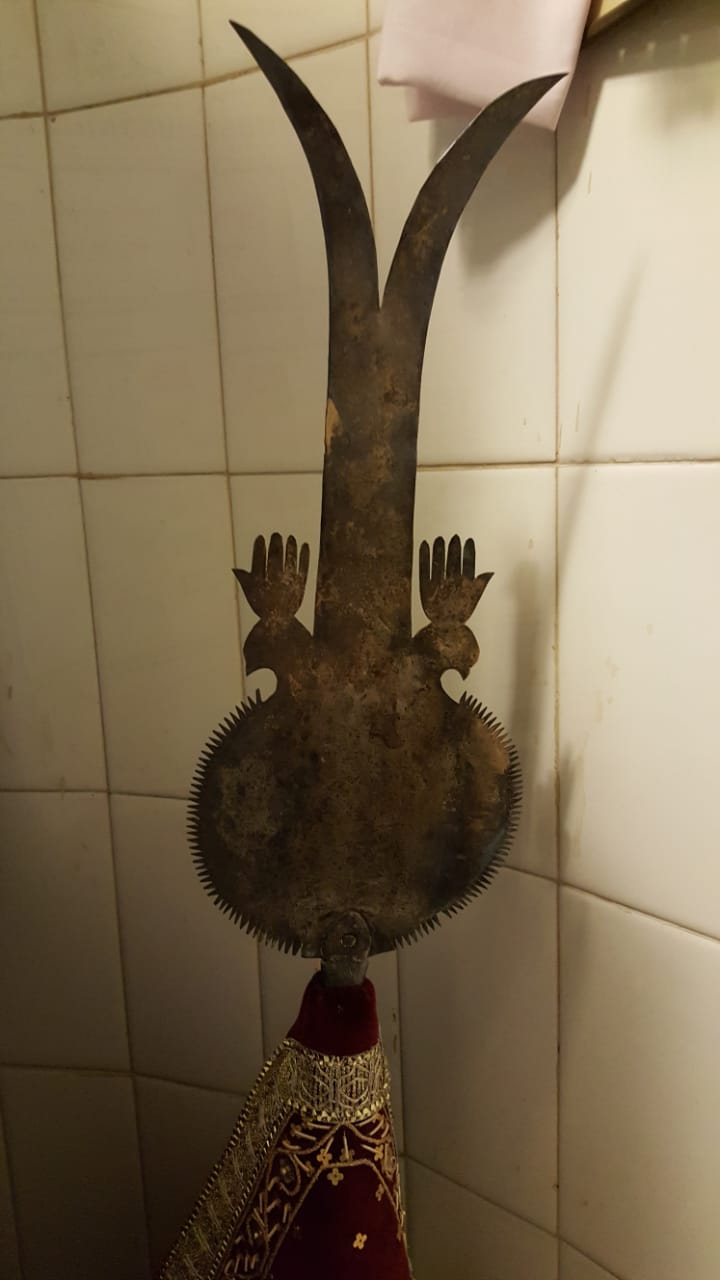
Doves have a crucial role in the Battle of Karbala.After the martyrdom of Imam Hussain the doves covered themselves in the Holy Blood and flew to Madina to give the tragic news to Bibi Sughra(Imam Hussain’s daughter )who was left behind because she was unwell.
During my stay in Bangalore I had the privilege of meeting and interacting Aunty Nagineh and her family.
Aunty Nagineh comes from a very distinguished family of Bangalore.She comes from the family of Sir Mirza Ismail who was the Diwan (Prime Minister) of Jaipur, Hyderabad and Mysore ,before the Independence of India .He is responsible for a number of distinguished projects in his lifetime.
On one of my trips to her home in Bangalore I chanced upon seeing her small Ashoorkhana in which she has two Alams, one of which has a dove motif.
She told me an interesting story about how she chanced to find these precious objects.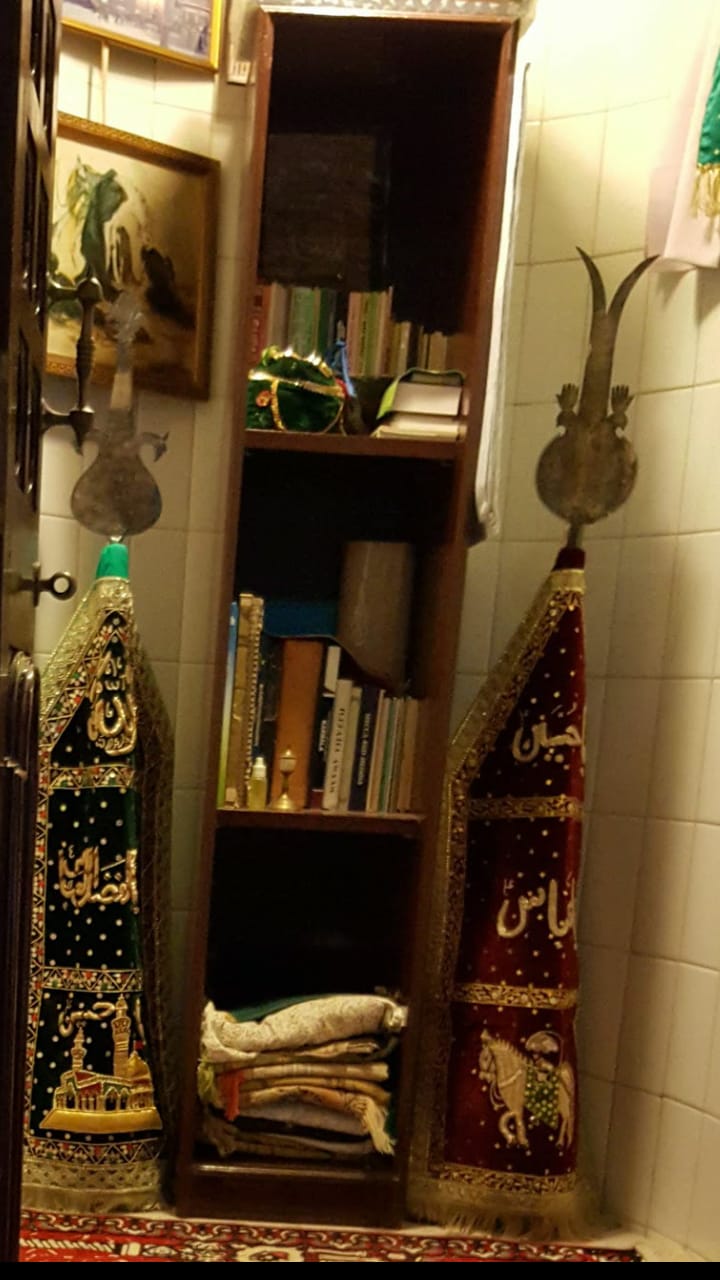
She had gone on a shopping trip with a wife of a Minister from Tunisia,when she saw these two beautiful Alams lying in a dusty antique shop in Lavelle Road (Bangalore) .She brought both Alams home.Till now she says no one has been able to make out which metal they are made from and they are so ancient that the script on them is almost erased .
(4) Panja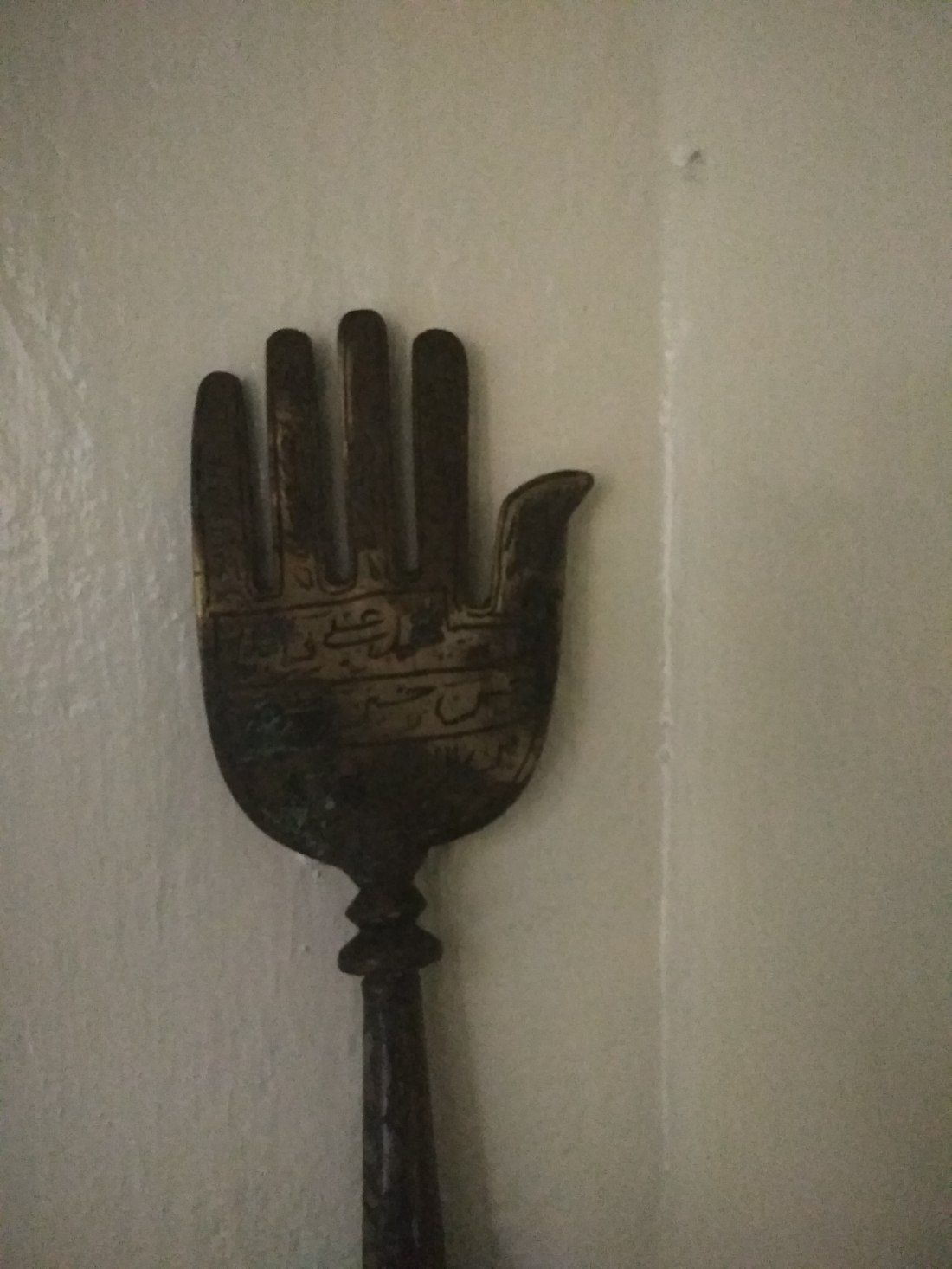
The word’ Panja’ means five ,it represents the five infallible( 1).Prophet Muhammad ,his daughter(2) Bibi Fatima ,her husband(3) Imam Ali and their sons (4)Imam Hasan and (5)Imam Hussain .
Panja on Alam can also represent the slain hands of Abul Fazl Abbas ,who was the step- brother of Imam Hussain and whose hands were chopped mercilessly by the enemies when he went to get water from Nahr-e-Furat branch of River Euphrates )in Karbala for the thirsty children in the camp of Imam Hussain .
(5) Fish: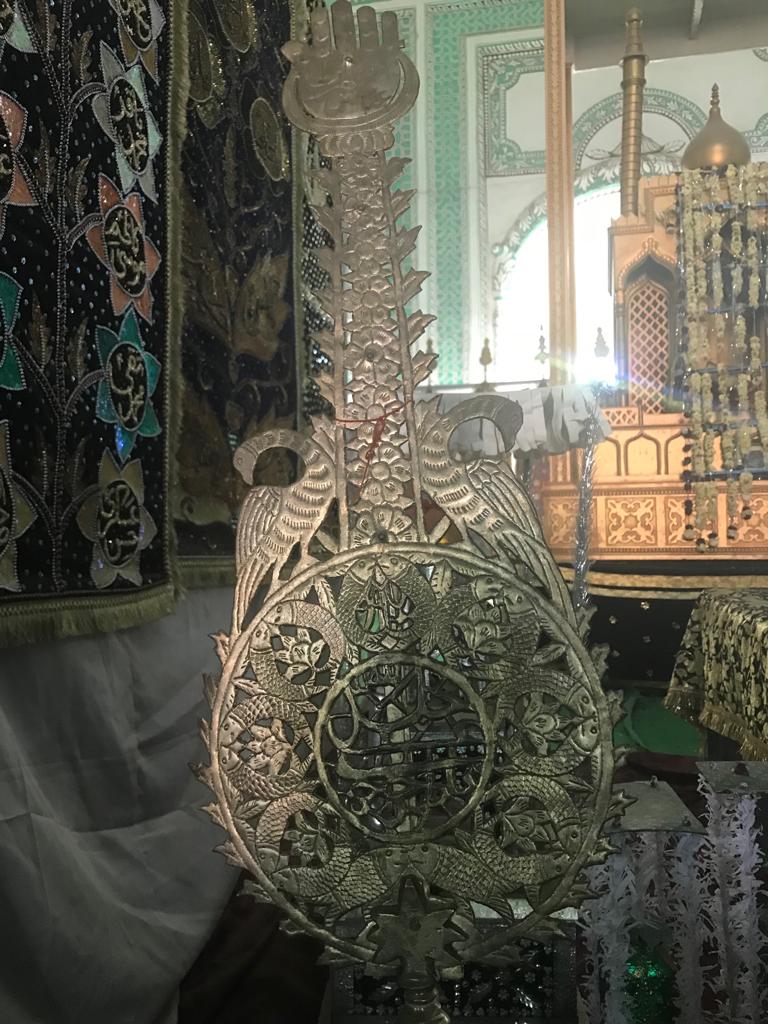
Widely used in the decorative arts of Persia ,China and Japan ,fish is a universal symbol of good luck,prosperity,fertility and feminity but nothing interests me more than the explicit use of this symbol in the handicrafts ,arts and above all in the buildings both public and private during the Nawabi Era in Lucknow.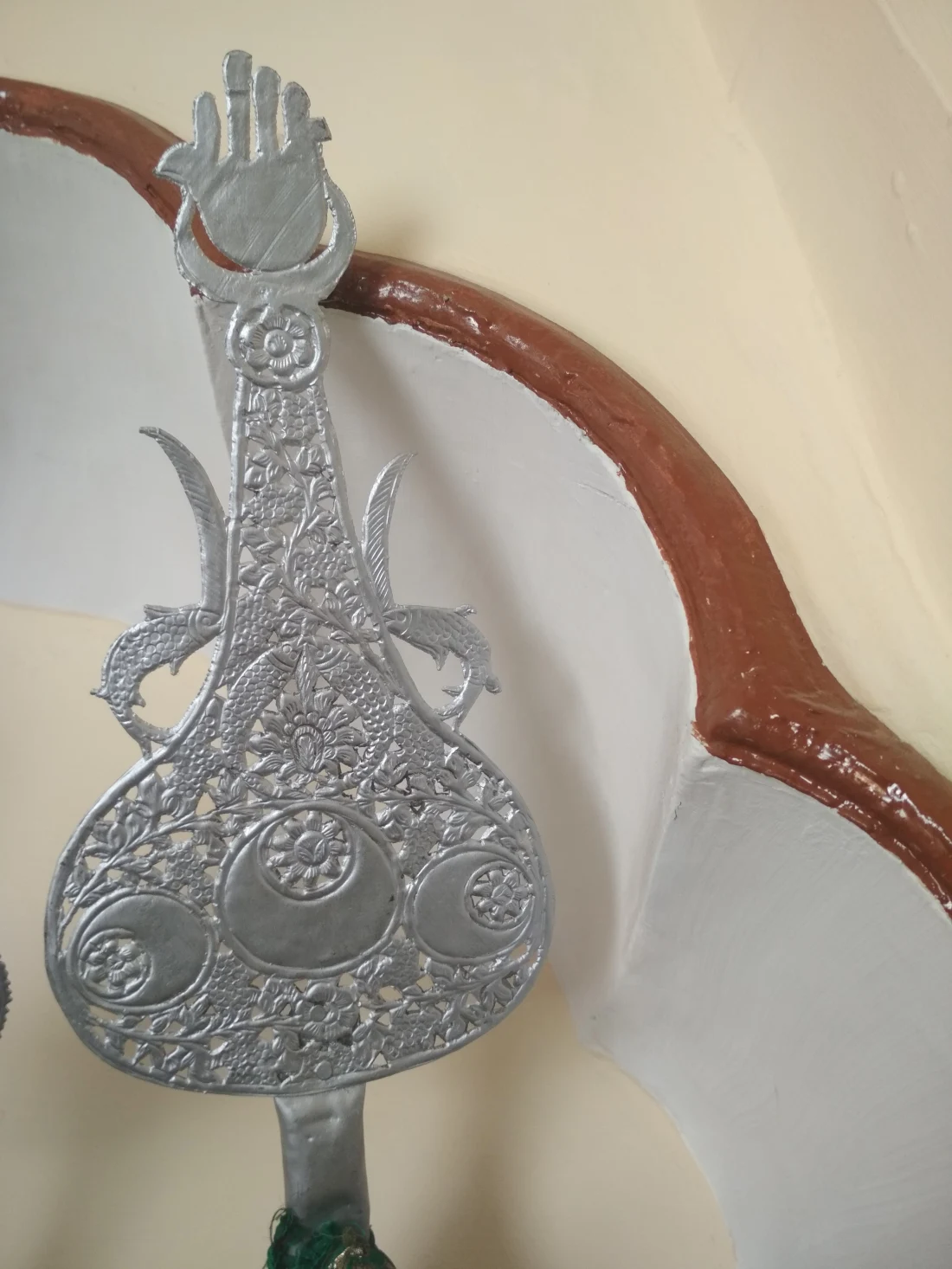
The story goes that:Nawab Saadat Khan or (Burhan -ul -Mulk)after being appointed Governor of Awadh was crossing river Ganga on his way to Lucknow when two fish leaped on his lap .It was considered as a good omen.Thus began the golden age of arts and culture under the Nawabs of Awadh.
No wonder this symbol has found its way on the Alam . For Shias this symbol represents the Last of the Twelve Imam (Imam Mahdi) .
During the birthday of Imam Mahdi which falls on the 15th of Shaban (Islamic Month) they throw their wishes written on a piece of paper called Areeza into a lake ,river ,ocean or any other water body.They believe that the fish will carry their message to the Imam ,who will in turn fulfill their prayers.
(6) Zulfiqar: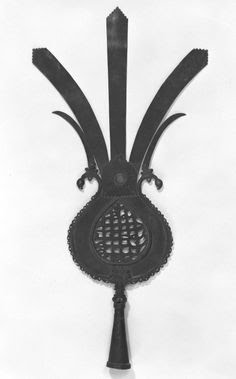
The two edged sword of Imam Ali is called the Zulfiqar .It is believed that Zulfiqar was a (divinely blessed sword)with which Imam Ali performed tremendous feats of valour.
It has found relevance in a number of medium one such being on the Alam .It represents the Sword of Truth and Justice.
(7) Buraq:
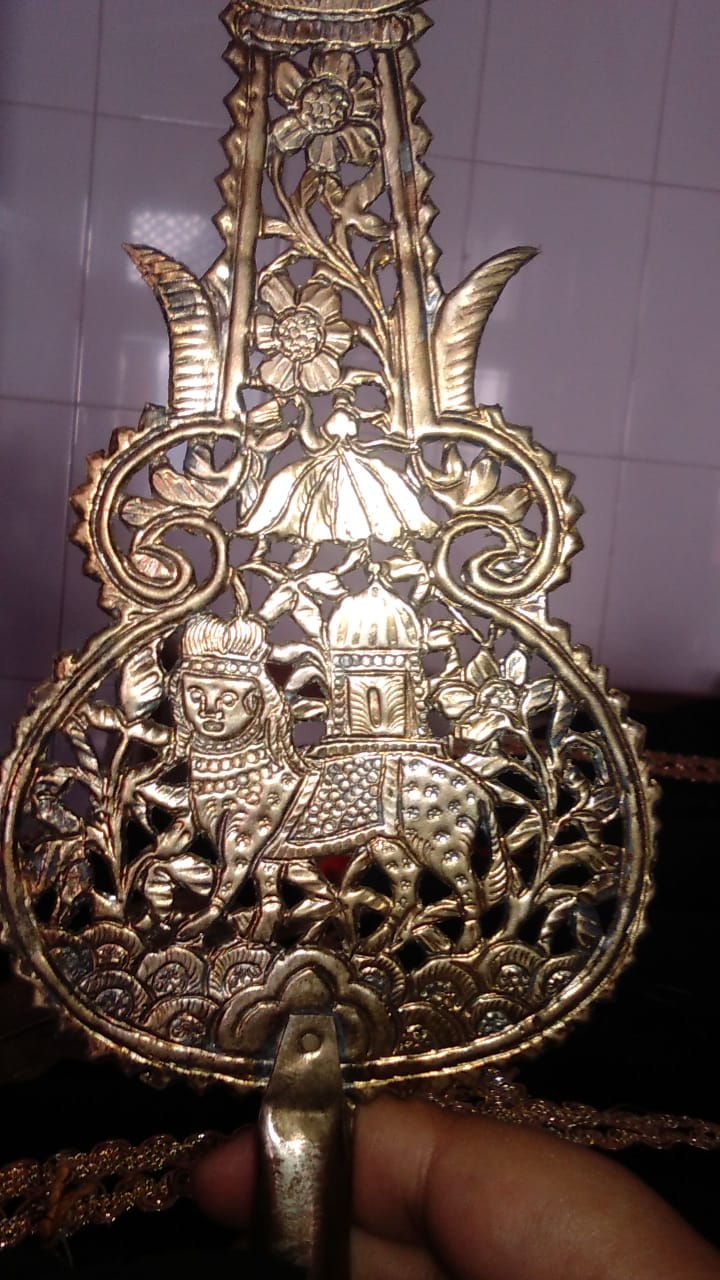
Al-Buraq is a steed in Islamic Mythology a creature from heaven that transported the Prophets.
The word Buraq is derived from Arabic word barq which means” lightning”.
Buraq in Islamic traditions most notably is a creature said to have transported Prophet Muhammad on his journey to heaven.
East and Persian Art almost always portray Buraq with a human face,a portrayal that found it’s way into Indian and Persian Islamic Art.
In my quest for various motifs on Alams I found a very unique discovery in my Paternal Aunt’s Azakhana ,which is located in the old city of Lucknow.I would be forever grateful to my cousin who took the pain to find it out for me and send me it’s photograph.It’s quite a unique antique Alam which is no longer displayed in the Azakhana.But is preserved and cared , for fear of being damaged.
(8) Lion :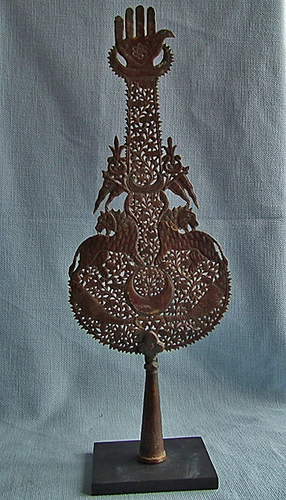
Throughout centuries ,the lion has been acknowledged as a symbol of power in numerous cultures.
Prophet Muhammad’s Uncle Hamza ibn Abdul Muttalib had the title of the,”Lion of Allah “.This is in the context of Hamza being amazingly brave .
In Shia Islam ,the lion motif represents as a symbol of strength.Prophet Muhammad gave Ali (First Shia Imam )the name “Asadullah “which means the Lion of God .
(9) Zuljanah :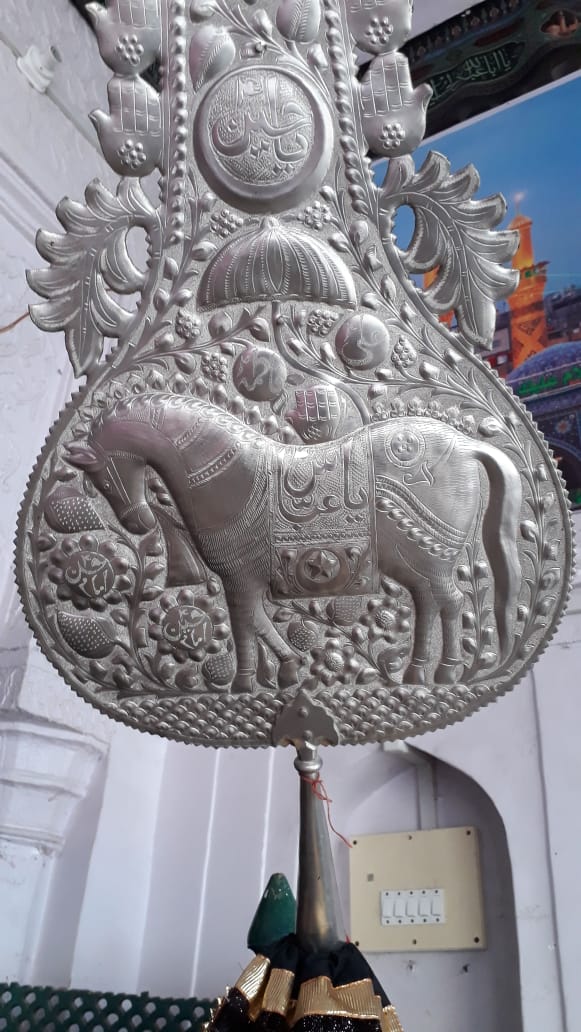
Zuljanah refers to the name of the loyal horse of Imam Hussain who stayed with him in the battle field of Karbala till his last breath. He was bought and grown up by Prophet Muhammad.
Zuljanah played an important role in Karbala, by bringing the news of Imam Hussain’s martyrdom and covering his body in the Holy Blood of Imam Hussain and giving the sad news of his martydom to the ladies and children of his family in the tents at Karbala.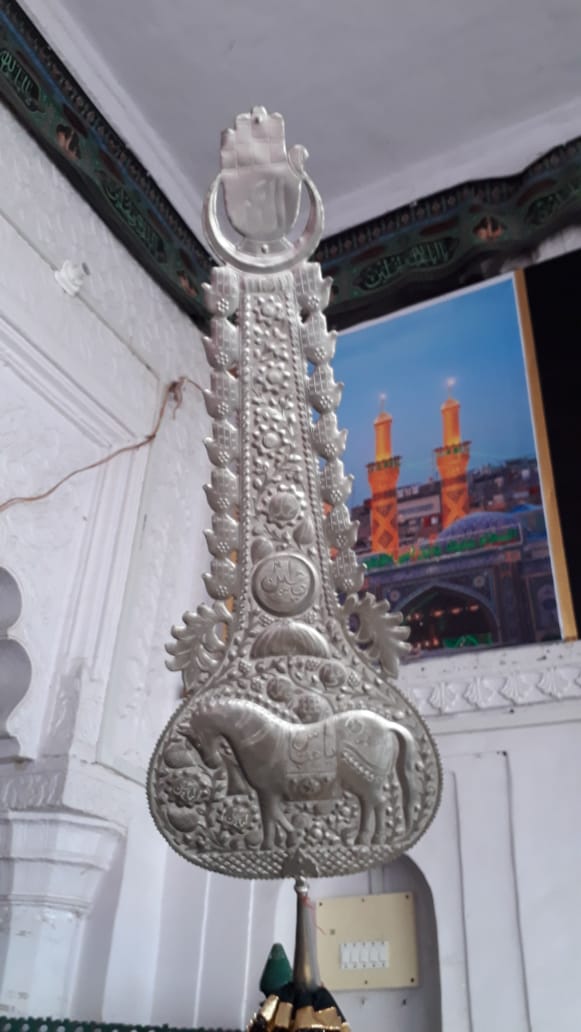
This particular Alam finds a place in Diwan -Khana or Court Chamber of my ancestral place (Mustafabad) in Uttar Pradesh .It adorns the mimbar or the pulpit from where eulogies are recited in honour of the supreme sacrifice of Imam Hussain and his army of 72 faithful followers.
(10) Mirror writing: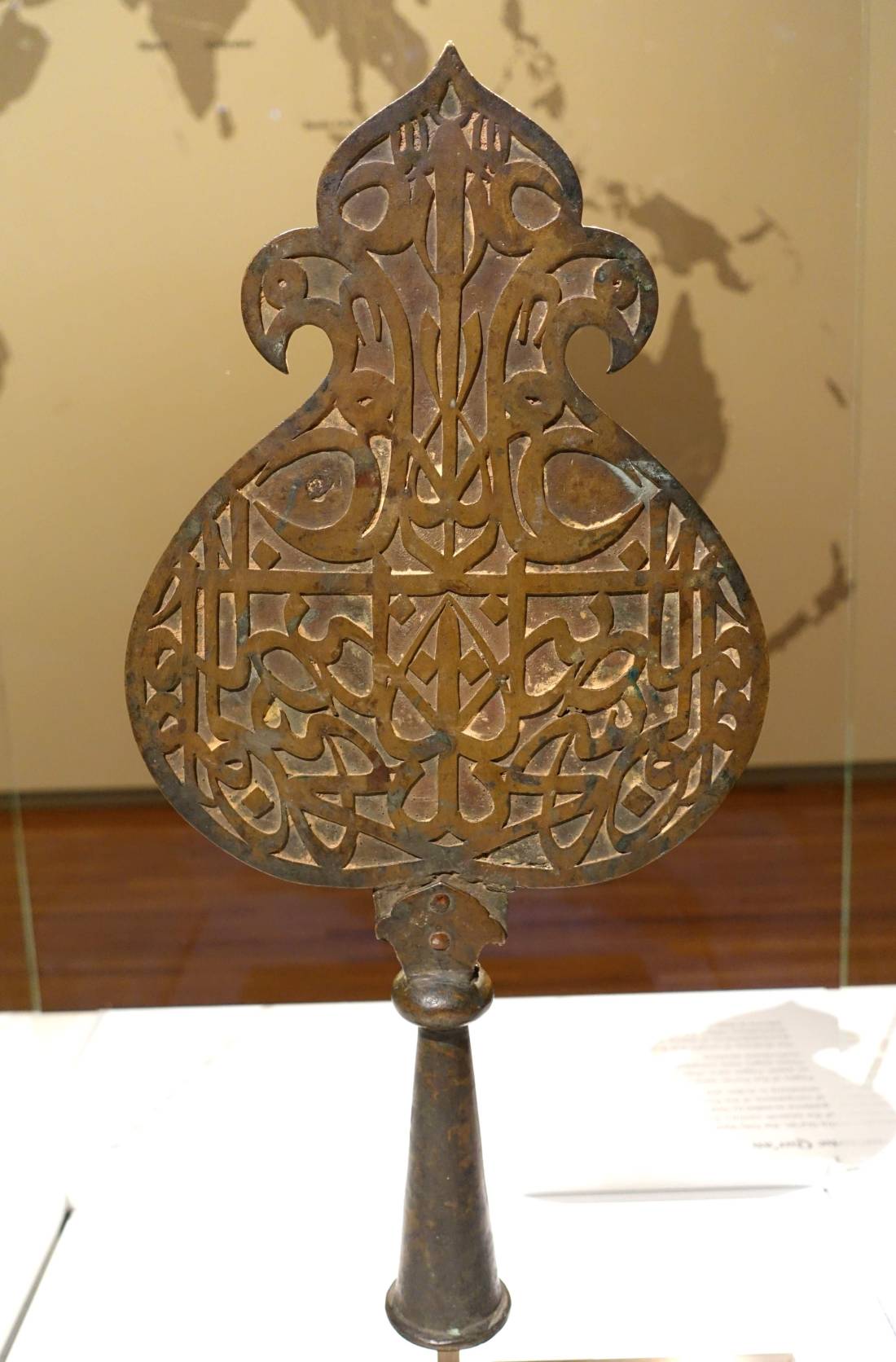
Maraya or ,”Muthanna” is the technique of mirror writing in which the composition on the left reflects the composition on the right.
It was known since 17 the century and was particularly appreciated in the 19th and 20th century.
Scholars accept mirror writing as a standard form of Arabic script calligraphy.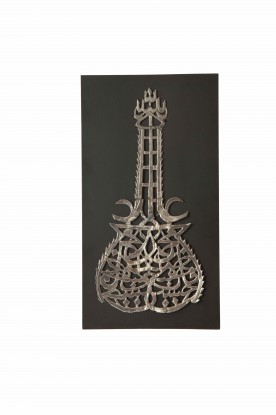
Calligraphic roundels in mirror image are primarily found on architecture ,in few cases mirror image writing was applied as illumination in many album pages and manuscript,but they also appear in other medium such as Alam (processional standard).
(11) Blades: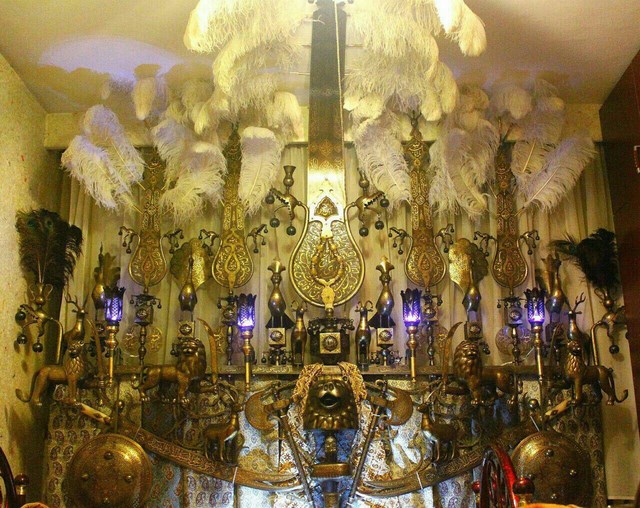
There are 14 blades that can be used on Alam or Alamat in Iran .The existence of 14 blades represent the Twelve Infallible Imam’s and Allah and Prophet Muhammad.
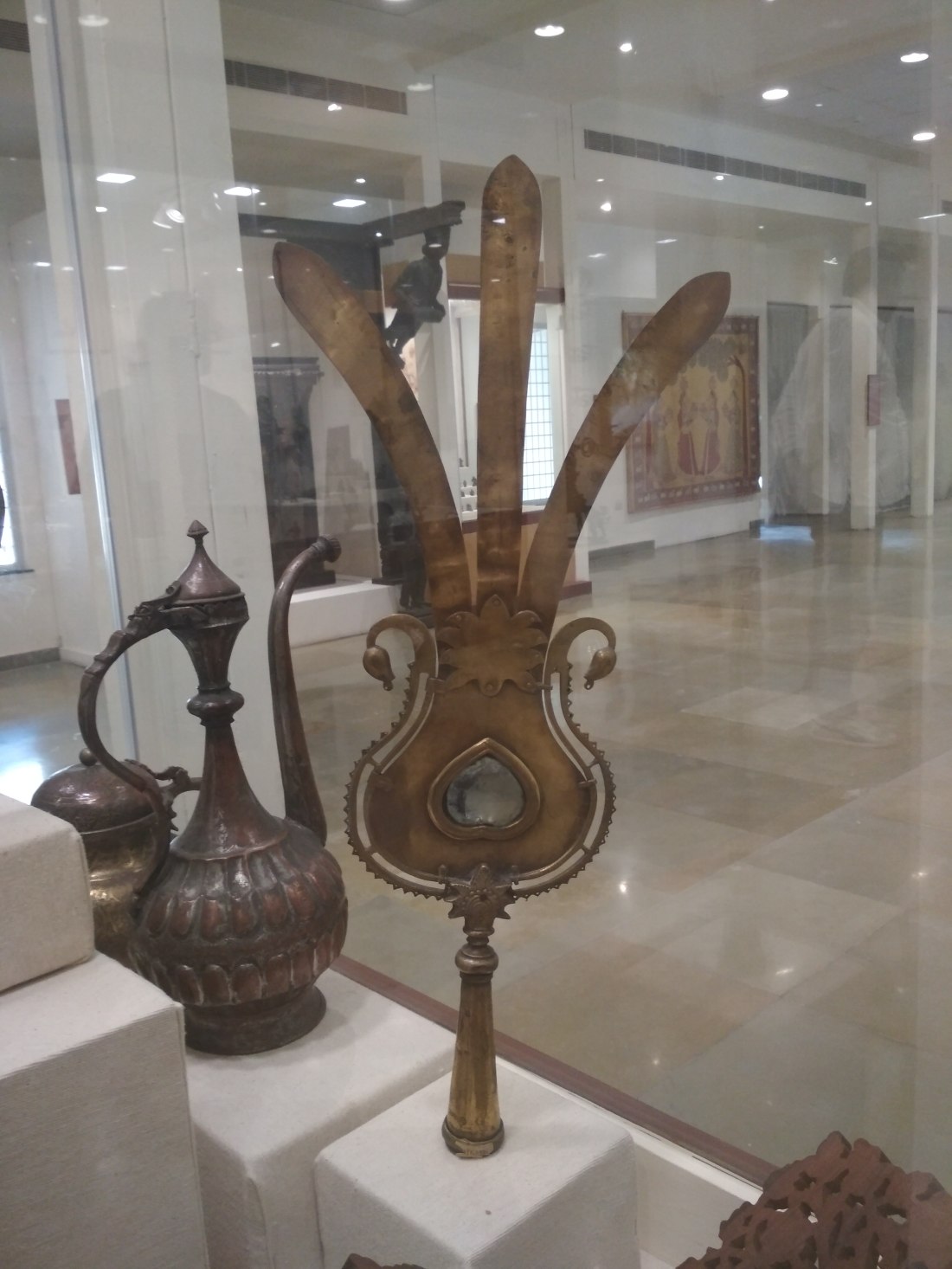
Three blades common on Alams in India represent Imam Hussain as he is the Third Imam of the Shities.
This particular example can be found in the Crafts Museum , Delhi.
(12) Dragons :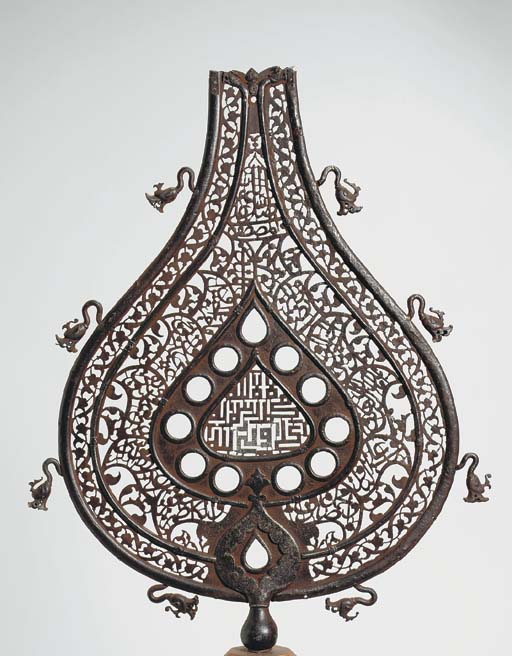
There are three mythological characters pre-dominantly represented in Islamic Art.
(1) The Islamic Sphinx
(2) Phoenix
(3) Dragon
Dragons were written about in Persian literature such as Shahnama or the Book of Kings .It was written by Firdausi by 1010 A.D.
Shahanama is an epic poem which narrated the glory of Persia before the introduction of Islam.
It contains mythological creatures and historical references and included stories of heroes fighting dangerous beasts.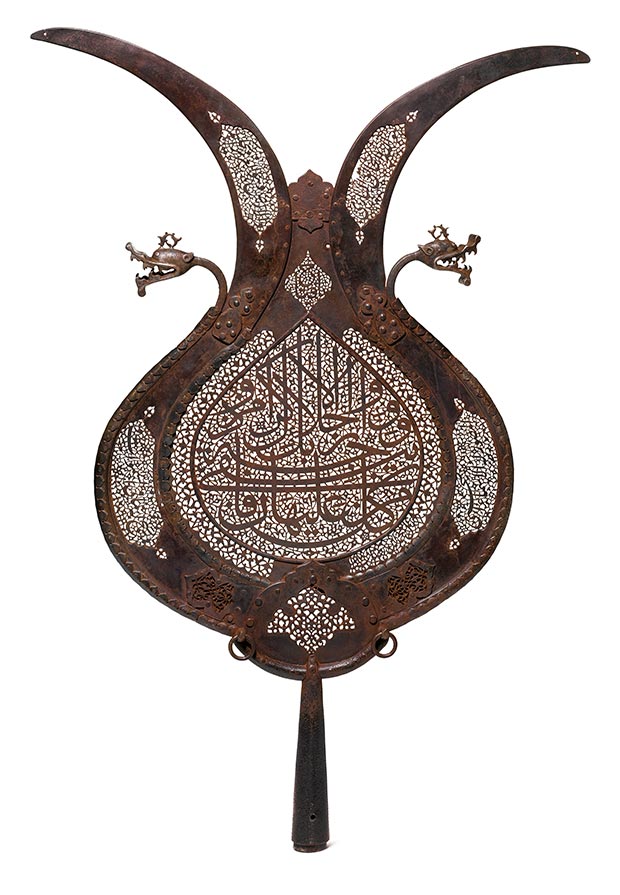
Dragons on Persian Alam represent power and strength on battlefield.It can also represent Jinn (a makhlook(creation) created by Allah and made from Fire) .It finds mention in the Holy Quran and an entire Chapter in the Holy Quran is called Surah Jinn.
The story of Jinn finds mention in the Battle of Karbala ,where Zafer -e -Jinn the leader of Jinn’s asked the permission from Imam Hussain to fight on his behalf and the Holy Imam refused his request by saying it was a battle between right and wrong and it was his Jihad for Justice.
Dragons in Deccan: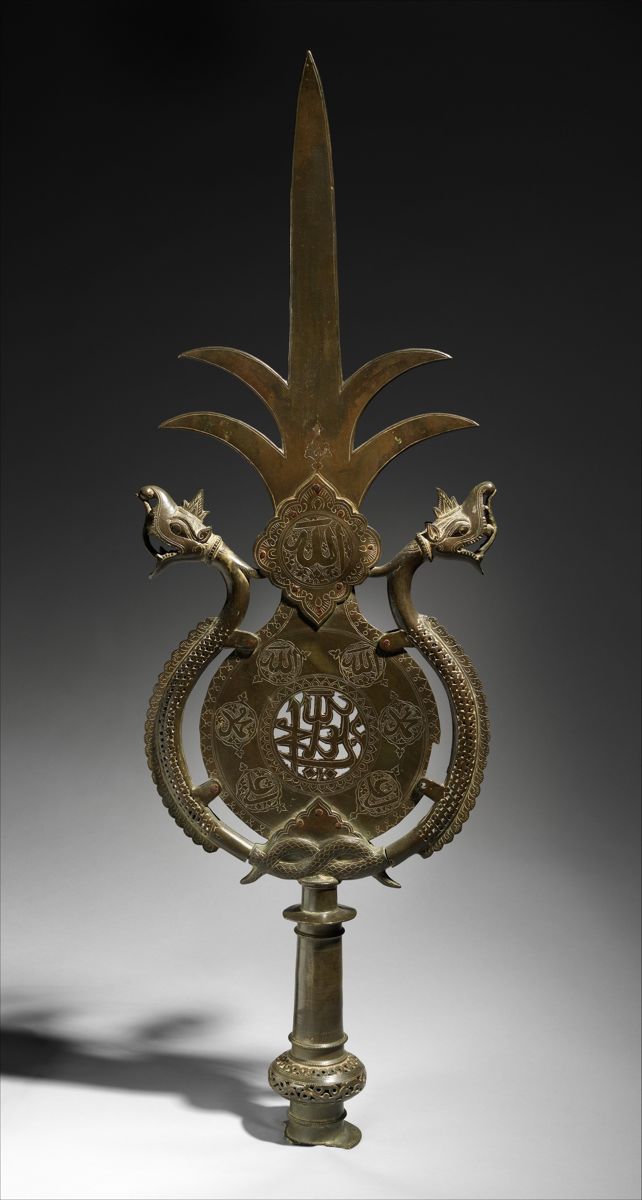
Stylised dragon heads are often found on 17th and 18th century Deccani Alams .
The form was developed in Iran during the Timurid period and was derived from a Chinese prototype.
The dragons on these Alams have a serpentine look that is characteristic of Deccani interpretation of this motif.
Hyderabad Deccan Alams:
The Alams from Hyderabad Deccan is totally different and distinct from the ones in North India .Influence of Persian Art is more distinctive in the Alams of Hyderabad especially in the use of dragons .
The Qutub Shahi era Alams have more Persian influence than the Adil Shahi one’s informs me Mr. Mir Inayat Ali from Hyderabad .
The Ashurkhana’s in Hyderabad unlike in North India have mostly Alams( of all sizes )commemorating the tragedy of Karbala.
They are arranged in a single row ,or double depending upon the size and use of Alams .
Hyderabad Ashurkhana’s:
The city of Hyderabad has a rich and ancient history , scattered along it’s periphery are Ashurkhana’s or (mourning halls) dating back to the Qutub Shahi period .
These Ashurkhana’s serve as a place to commemorate the Tragedy of Karbala by the people who come to pay their respects to the Holy Imam .
Here is a list of the Ashurkhana’s in the city ,it’s quite a long list that I’ve shortened taking into account only the one’s which are famous and contain certain sacred relics which are enshrined into the Alams .
1.) Naal e –Mubarak
2.) Baadshahi Ashurkhana
3.) Bibi ka Alawa
4.) Bargah e-Hazrat Abbas
5.) Alawa e-Sartauq Mubarak
6.) Hussaini Alam
7.) Panje Shah -e Vilayath
8.) Qadam e-Rasool
9.) Khilwath Mubarak
10.) Koh e -Maula Ali
11.)Yateemo ka Alawa
12.)Koh e- Qayam
Lohe ki Kamaan: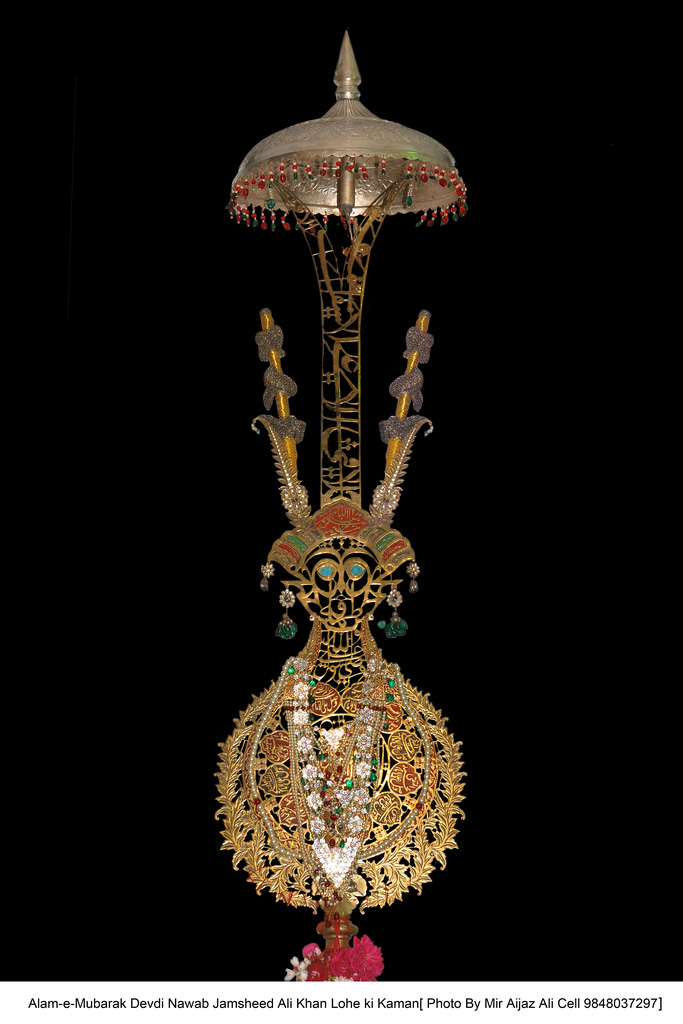
This particular Ashurkhana has Alams that look like human faces , Wikipedia describes these Alams as ,”uniquely in the shape of a Tughra ,the only known representative of this type”.
I got the opportunity to speak with Mr.Mir Inayat Ali ‘Khan’ Abidi who is eight generation taking care of this sacred site .
He was kind enough to share his knowledge on these sacred Alams and their history.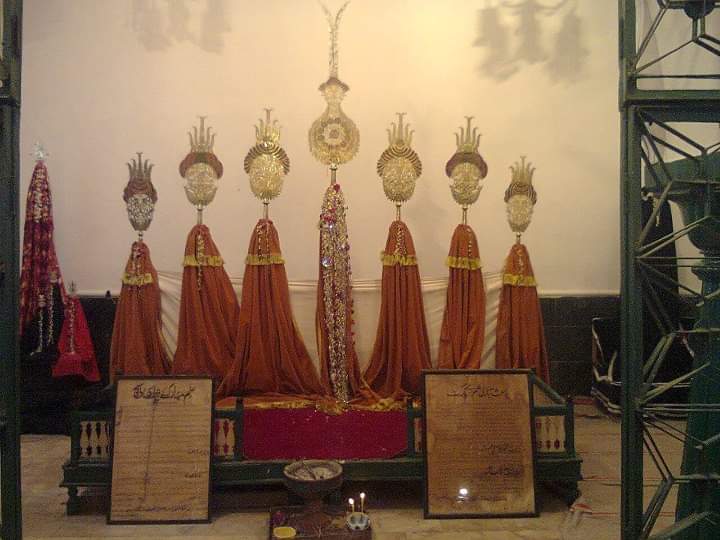
He describes them as Zoomorphic script or Calligraphy of living creation .
He explained to me in detail about the Calligraphy on these unique Alams, especially the Centre Big Alam :
(1.)On the top is Chatr-e-Shahi or Royal Umbrella.
(2.)Turrah (headgear)is on both sides with silver wires , wrapped around a golden stick .Turrah was worn by Persian nobility at one time.
(3.)Two diamond Sarpech,(Sarpech is a turban ornament that was worn by significant Hindu and Muslim princes. The Sarpech is on either side of the Turrah.
(4.) Zulfiqar or two pointed sword of Imam Ali has La fata illa Ali la Saif illa Zulfiqar in beautiful calligraphy.
(5.)Crown :has Bismillah written over it.
(6.)Face:has names of the Holy Panjetan or Holy five names from Prophet Muhammad’s family.
(7.)Neck :has Aliyun Wali Allah Wasi e Rasulullah in beautiful calligraphic script.
(8.)Centre:la ilaha illallah(there is no God but Allah)
(9.)Surround :names of 12 Imam’s and Prophet Muhammad.
Surrounding smaller Alams have the Names of Panjetan or Five Holy Names from Prophet Muhammad’s family.
He narrated me the whole story behind these relics and how his ancestor Syed Muqarram Ali Khan Abidi (Qaiser Jung)(who was a Minister during the time of the 3rd Nizam Sikander Jah )got sick and vowed to built a unique Ashurkhana if he was cured of his illness .The story goes that he was cured of his illness and to fulfill his unique vow he was very disturbed,then he saw a dream in which he saw Imam Hussain passing him some drawings or naksh .Within the same period the care taker of Bait ul Muqqadas (Jerusalem) Ghulam Ali also saw the same dream and he was asked to visit the Syed in Deccan .Ghulam Ali narrated his dream ,he happened to be a calligrapher too .He has designed the motifs on these Alams based on his dream.The Persian narration describes these Alams written as ,Soorat -e -Barzakh.
This event finds mention in a book called Silsila e Qaisari , written by Mir Yawar Ali .
Miscellaneous:
Apart from the motifs which form part of Alams there are various other motifs represented on Alams some of which are mentioned below:
Cresent shape,Pear shape,Spear, Mirror on Alam,Helmet too forms a unique part of Alams in Iran.
I would welcome more information on motifs on Alams ,I’m sure there might be more.I’ve tried my best to touch the base of the subject in the easiest possible way.More information is always welcome.
ALEM:
The word Alem ,has no relation with Alam used in Muharram.I wanted to include it because it’s word sound similar and it’s meaning is slightly similar to Alam .
An Alem in Turkey is a type of metal finial .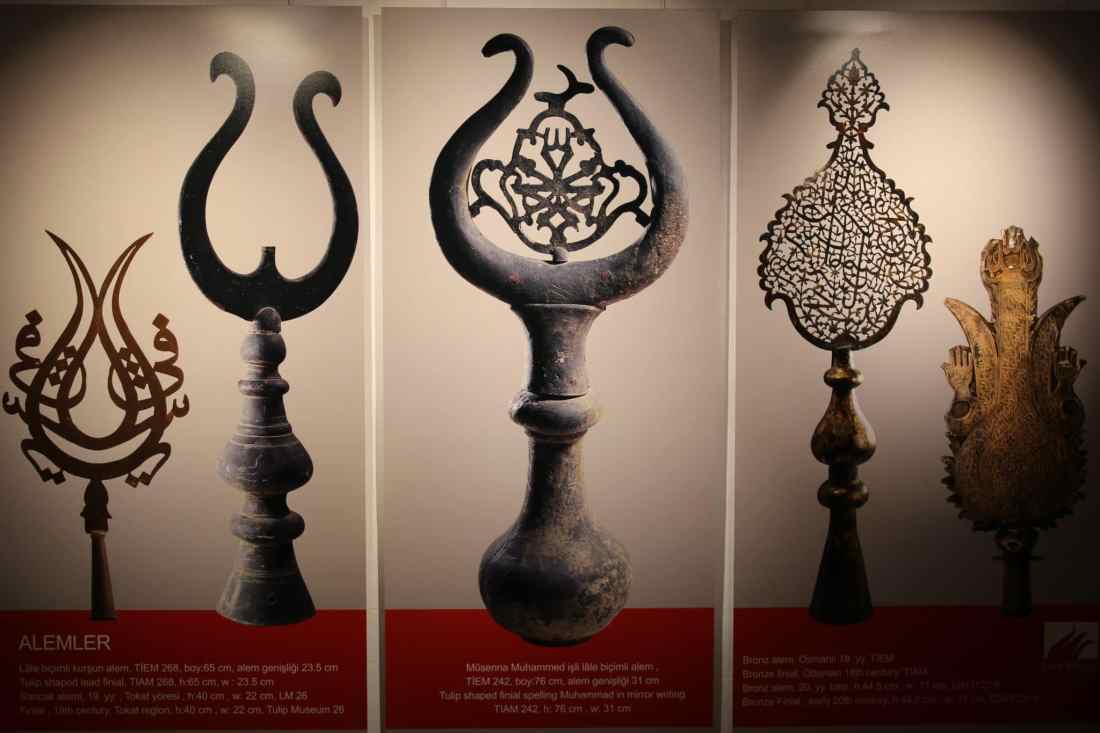
In Ottoman Turkish ,the word Alem means a military banner,consisting of a tall pole (sap) with a silk flag or banner (sancak)topped by a metal finial (saya).
The word Alem can also came to be applied to the architectural device which caps a minerat,dome of a mosque ,or mimber (pulpit).
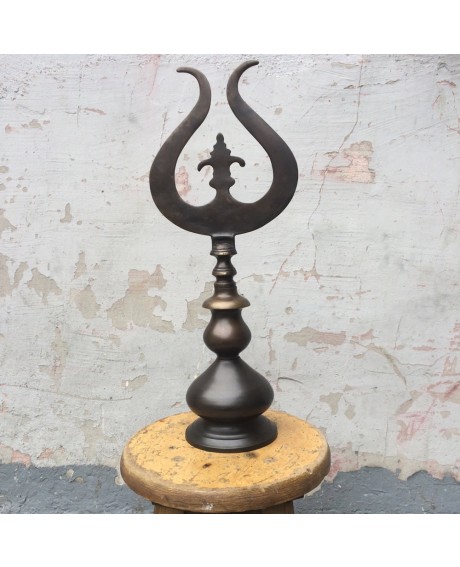
It may incorporate an Islamic emblem of the crescent (with star),a tulip etc.
Alam or Alamat motifs in Iran:
Bells: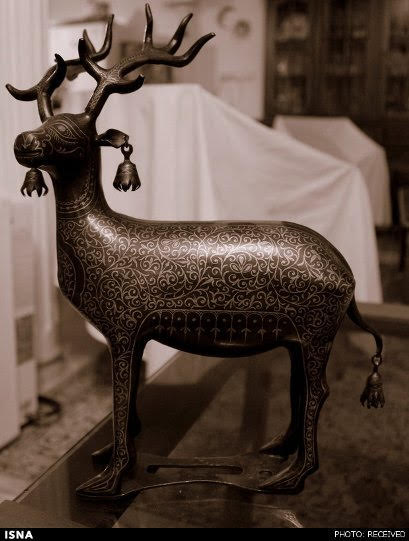
The bell is a symbol of Haydari’s ring ,when the Alam or Alamat shakes,the sound of the bell expresses Haydar,Haydar.
Blades: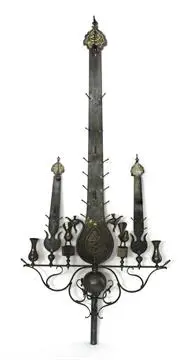
The blades on this Alam or Alamat is three ,representing the third Imam of Shia Islam (Imam Hussain a.s.).
There are can be more blades that can be used on the Alam or Alamat and depending upon the choice it can go upto 14 blades .The blades are decorated in poems in praise of Holy Imam’s or they can have a particular Quranic Ayat beautifully embossed on them.
Dervish Axe or Tabarzin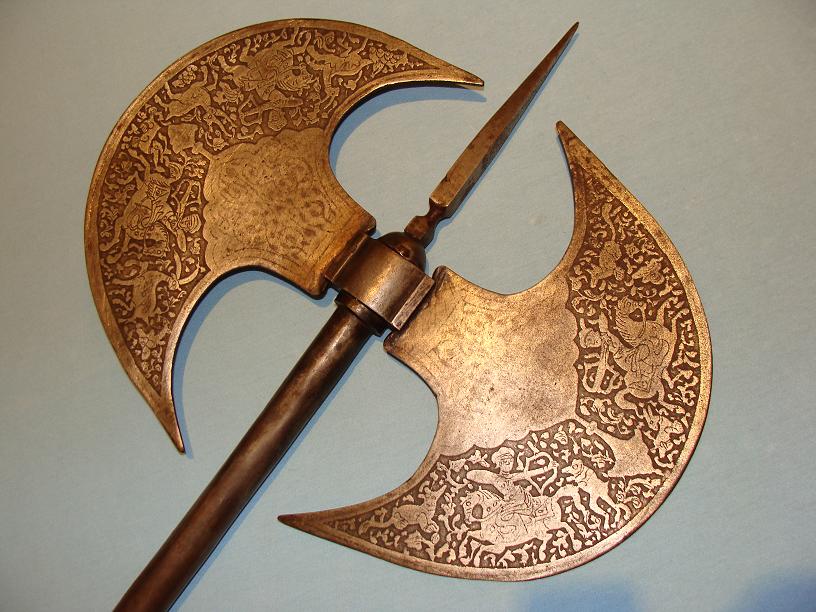
Tabarzin (saddle axe) is the traditional battle axe of Persia (Iran).It bears one or two cresent shaped blades.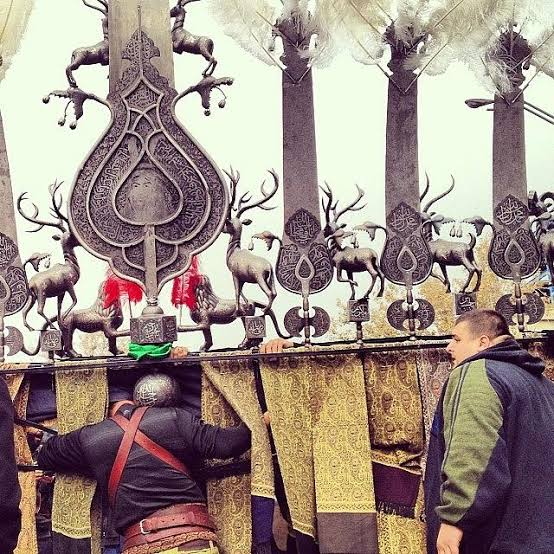
The tabarzin was sometimes carried as a symbolic weapon by wandering Dervish or Sufi mystics.
Animals used in Alamat :
Animals that are represented on Alam or Alamat are those according to tradition who have cried over Imam Hussain after the event of Karbala.
Or either they are associated with an event during the lifetime of Prophet Muhammad and his blessed family.
They include Doves, Peacock,Lion,Deer ,Camel,Buraq etc.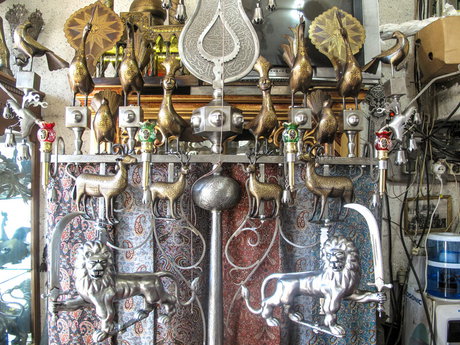
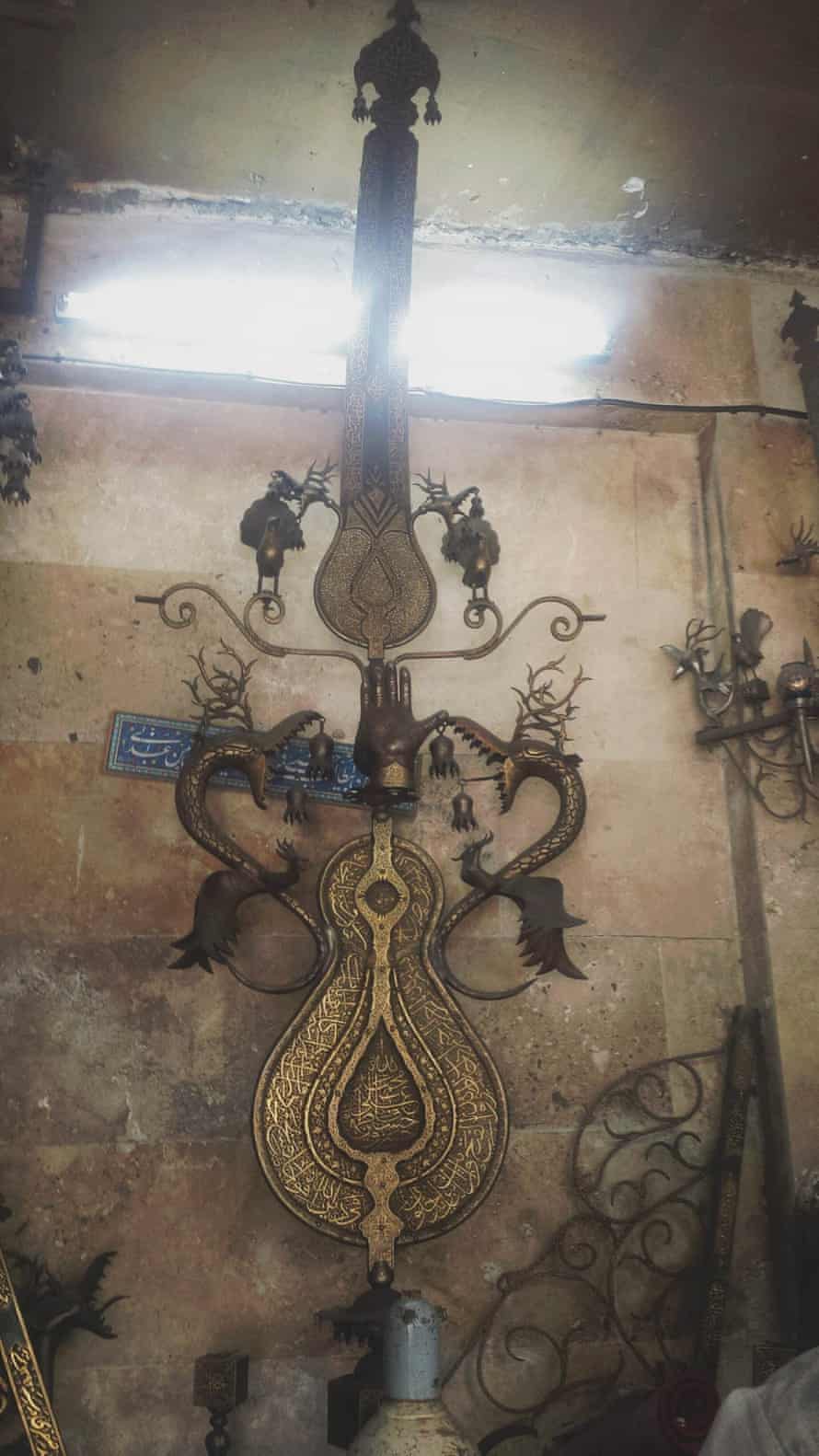
Alam or Alamat are represented using calligraphy invoking the names of Holy Prophet and his progeny ,or poems in praise of the Holy Imam’s or they can also include Quranic Ayats too.
Lamps and Flower Vases also find place on the Alamat representing peace ,blessings and guidance.
Interesting finds:
BOOKS:
There are various books on Azadari published in major languages of the world including English,Persian ,Turkish ,Arabic ,Urdu ,Albanian,Chinese etc.
(1) There is book written in Persian which is called Farhange Ashura or Ashura Encyclopaedia , written by Shaykh Javad Muhaddethi.
(2) The martyrs of Karbala :Rituals in Modern Iran written by Kamran Scot Aghale
(3) Azadari ki Tareekh a book in Urdu written by Mr.Sibtul Hasan Hansavi ‘Faazil’.
(4) Hyderabad ki Azadari by Dr.Sadiq Naqvi.
(5) Rekhta organisation has a book online by the name of Azadari e Imam Hussain a.s. Ek Afaaqi Tehreek or (International Movement of Mourning Imam Hussain ) written by Dharmendra Nath
(6) I also found a book which was in my father’s library collection , written by Nadeem Hasnain and Abrar Hussain published by Harnam publications.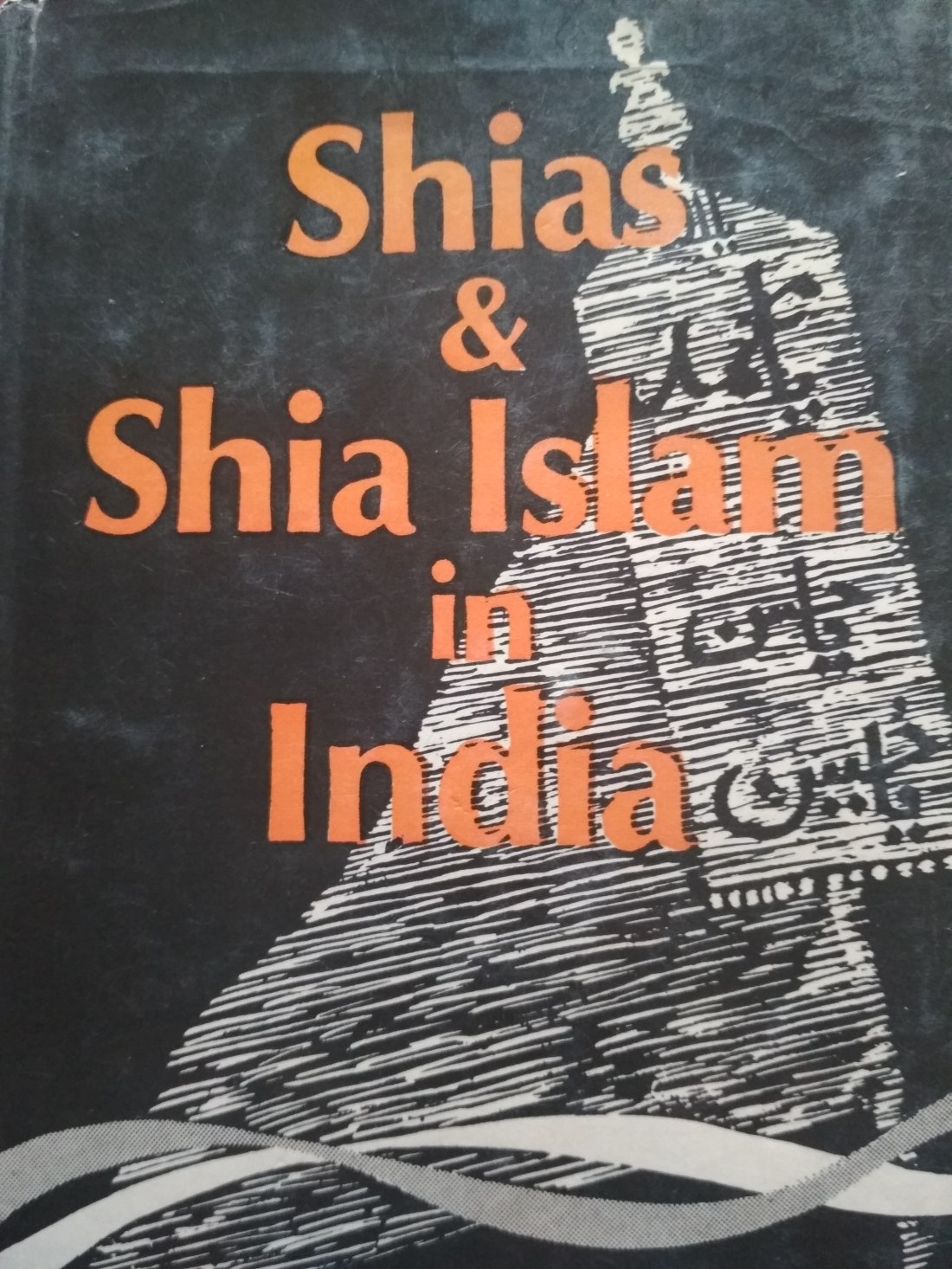
It explains the growth of Shia Islam in the Indian -Subcontinent,in society and culture.
BLOGS:
(1) In the course of my research ,I came across a blog on Muharram rituals by Dr.Mazhar Naqvi called the , Muharram Mirror.
(2) Mr.Deepan Ghosh has written extensively on the Imambara or Ashurkhana’s of Kolkata in his blog The Concrete Paparazzi .His article is complete with phone number ‘s and address of the various heritage Ashurkhana’s of the city .
Muharram Museum 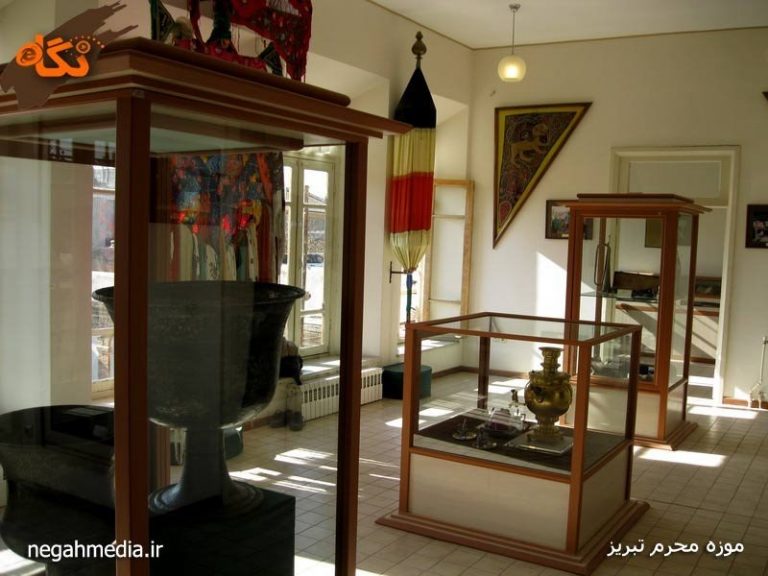
Muharram Museum is an anthropological museum in Tabriz,east Azerbaijan province Iran.
Anthropology is the study of people’s culture.This museum symbolises all the ceremonies and traditions of Muharram in Iran .
Established in one of the historical and cultural houses of Tabriz city.It is located on Rasteh Kuche Street.
The aim of the Museum is to display the material ,symbols etc used in the month of Muharram.
Iran being the centre of Shia Islam and having the largest Shia population in the world it is no wonder that they have tried to preserve and present their culture beautifully in the form of a Museum which is a great reference point for scholars and individuals who wish to know more about Azadari and it’s impact on Iranian culture.
Quotation:
Many great philosophers,educationists and,leaders of the world have paid tribute to Imam Hussain and one quote of French writer Victor Hugo has touched my heart deeply .He says,
“The principles of Hussain’s revolution became a path for every rebel who wants to tear out his right from the hands of his oppressors”.
Acknowledgements:
Had it not been the collective effort of the individuals (I acknowledge personally )I would have not been able to write on a subject that is of religious and cultural importance.It transcends boundaries and has been culturally rich in itself .
I would like to thank:
Mir Jafar Abdullah (Lucknow),Mrs.Nagineh Rizvi (Bangalore),Maulana Qambar Ali Rizvi (Rae Bareli),Janab Owais Naqvi (Mustafabad) Salman book centre ,Hyderabad,Mr.Mir Inayat Ali Khan Abidi (Hyderabad)Mrs.Naheed Hasnain (Lucknow),Mrs.Naghma Hussain Abidi (Lucknow)
I’ve tried to gather as much information as I could, to present a distinctive picture of the Alams which forms a revered part of Muharram rituals.
I would welcome new information on this subject and would accept with all humility if any mistake (genuine one)is made. I’ve been very careful not to hurt the sentiment of anyone .In the course of my research I’m grateful to people who have given me their time and shared their views and knowledge.
Dedication:
I dedicate my article in the loving memory of all the countless, unknown and unsung craftsmen ,whose hands and vision brought out the beauty on a piece of metal or a cloth which was soothing to the eyes and senses apart from having a religious obligation. They worked tirelessly,and dedicated their entire lives in keeping up their traditions , invoking the praise of Allah, His Messenger ( Prophet Muhammad) and his blessed family.
Our elders and ancestors have also played a major role in keeping the message of Karbala alive,they have tried to preserve the art and heritage of Muharram ( in respect to Imam Hussain’s supreme sacrifice), that which has been passed down from generation to generation despite facing hurdles and challenges along the way.
It is through the sincere efforts of our predecessor’s (our elders) that we are extremely blessed to have our traditions and rituals alive to be passed down safely to the next generation.
Ek pal ki thi Bas
Hakoomat Yazeed ki,
Sadiyaan Hussain ki hein,
Zamana Hussain ka.


I have no words left to say anything about the blog..its incredibley ,well written passionate effort which shows your curiosity and love towards islamic arts and culture .you had put your heart ❤and soul in it..No one can write it as you have written it baji..well done..keep it up…🤗🤗🤗
LikeLike
Thank you so much Shabnoor,
It means a lot if someone appreciates your work and effort.It makes all the time and effort small in return to the precious words and encouragement.
LikeLike
Salamz Shahana
the article on alams once again shows your passion towards not only seeking but sharing knowledge as well. Hats off dear for taking up a subject that I always wondered about. It is indeed very comprehensive and informative. You have really taken pains to collect and collate a lot of information.
I never knew that the mirror image writing is specific to Arabs and has its own significance in this part of the world. In fact one of my research papers on the influence of mother tongue in English language learning covers this aapect. We had experimented and found that the students could read the mirror image of the text with ease.
Good luck
Love n hugs😍😘❤️
LikeLike
Salaam Samia,I feel short of words after reading your feedback on my blog.I brings me hope and motivation to do better.Since this subject was close to my heart and is also close to many people,I gave my heart and soul into it.And positive comments really matter to me especially after hard work.Thank you so much from the bottom of my heart.Jazak Allah Khair
LikeLike
Very beautifully written Shahana.Your passion for the subject comes across very clearly.
LikeLike
Dear Zebu , thank you so much for your wonderful support.I feel truly blessed.
LikeLike
All your blogs are always well researched, but this one took my breath away. I was unaware about so much of this, I hadn’t even given the motifs so much thought. But here I am, sitting reading this, tears streaming down my face, in awe of our rich heritage and grateful to you for sharing this information with us. Very well articulated and lovingly curated. Love it. JazakAllahu’Khayran’Katheer 🌹🙏
LikeLike
Dearest Sunbul,
I was so much nervous when I started writing on Alam motifs…. it’s so much still more to be discovered about such a revered symbol of Azadari.I’ve put my heart and soul into it and am still open to discover and write on them .God willing
With such a big positive response coming from family and friends,I’m hopeful to shatter the myths and break all barriers surrounding Azadari.
LikeLike
Great research work dear, lots of hard work and ur intense passion is visible. Congrats and best wishes.
LikeLike
Dear,Priya
It’s a wonderful feeling to know that you are recognised for your hardwork.Thank you so much.Hope to keep up with everyone’s expectations.
LikeLike
Dear, it’s great research that’s done on this subject by you. It gives a deep insight to the readers about these so commonly displayed motifs of azakhanas, the mutabarrik Alams that we have ever been giving ‘bosa’ to and praying under. Very well explained how they are connected to Imam Hussain A.s. and Hazrat e Abbas a.s. and the meaning of various figures that appear over them, something which I had never pondered over. Thank you for sharing your knowledge!
Keep up the good work!
LikeLike
Dear Kaukab,
I’m really falling short of words.Thank you for appreciating my work.I hope to keep up with everyone’s expectations.Insha Allah
LikeLike
I have recently acquired an alam. I did not know what it was (neither did the seller) – not even it’s name! I felt that the images of the lions on it looked a little Indian, and through research, I then found your enlightening blog! So interesting! I would like the know more about the alam in my possession. Would you be interested in seeing a photograph?
LikeLike
Hi Jo,
Such a delight to know that you have an Alam, and by blog helped to find it’s importance.
I would definitely be interested in your photographs. It would perhaps shed more light on it’s history.
Keep in touch!
And thanks for sharing your feedback.
LikeLike
Excellent Work Done, Highly Appreciated
LikeLike
This is a very informative article. Can’t thank you more. JazakAllah
LikeLike
Thank you so much Mahrukh.
It’s a pleasure to get wonderful comments.
LikeLike
Dear Shahana
No words to express my feelings for the article. My hobby is collecting vintage azadari stuff from round the globe .
Can I copy your article to give an insight about alams to my younger family members
LikeLiked by 1 person
Salaam,
I’m so glad to hear that you liked my article and even more happy that you collect vintage Azadari stuff. It’s so important to conserve our heritage.
You are most welcome to share my writing with family and friends.
Regards,
Shahana
LikeLike
یاحسین
Ya hussein
Tanks realy
Im from iran
LikeLike
Salaam ,
Thank you so much brother….
LikeLike
Yah Alam mil sakta kya adress bol Sakte
LikeLike